Farthest
- By Maggie Masetti
- December 18, 2012
- Comments Off on Farthest
I was inspired to pick up where Alexe left off with her “est” blogs, and write about “Farthest,” because of some recent, cool, astronomical news.
There was recently excitement over a Hubble Space Telescope discovery of seven primitive galaxies located over 13 billion light years away from us. The results are from survey of the same patch of sky known as the Ultra Deep Field (UDF). This survey, called UDF12, used Hubble’s Wide Field Camera 3 to peer deeper into space in near-infrared light than any previous Hubble observation.
Why infrared? Because the Universe is expanding; therefore the farther back we look, the faster objects are moving away from us, which shifts their light towards the red. (The opposite of the our namesake effect, blueshift!) Redshift means that light that is emitted as ultraviolet or visible light is shifted more and more to redder wavelengths. Spectral features from galaxies that we normally see in UV or visible are likewise shifted into infrared, particularly for the most distant things. Without infrared light we might not see those features, and thus couldn’t determine the distance to these far away objects.
The extreme distance of these newly discovered galaxies means their light has been traveling to us for more than 13 billion years, from a time when the Universe was less than 4% of its current age. (Current observations suggest that the Universe is about 13.798 billion years old.)
Their discovery, which you can read more about in the NASA feature is exciting because it might give us an idea of how abundant galaxies were close to the era when astronomers think galaxies first started forming. (Phil Plait has a good column about this discovery too.)
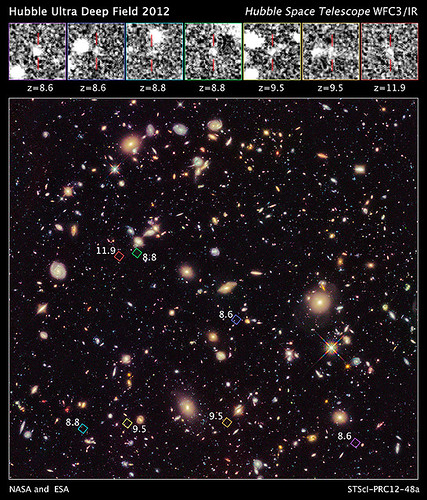
Credit: NASA, ESA, R. Ellis (Caltech), and the UDF 2012 Team
With every year that passes, our newest technology enables us to see further and further back. The microwave afterglow of the Big Bang that was seen by the COBE and WMAP satellites is from about 378,000 years after the Big Bang. That’s a long time ago to be sure, but it was also before the first objects in the universe formed.
The questions are, how far back can we see at visible and infrared wavelengths? And what can we see?
The Ultra Deep Field (UDF) is one of the deepest views of the visible universe to date; certainly it was the deepest when it was originally created in in 2003-2004. There are approximately 10,000 galaxies in this view, which is a sort of “core sample” of a very narrow patch of sky near the constellation Fornax. The smallest, reddest galaxies in the image, of which there are about 100, are among the most distant known objects!
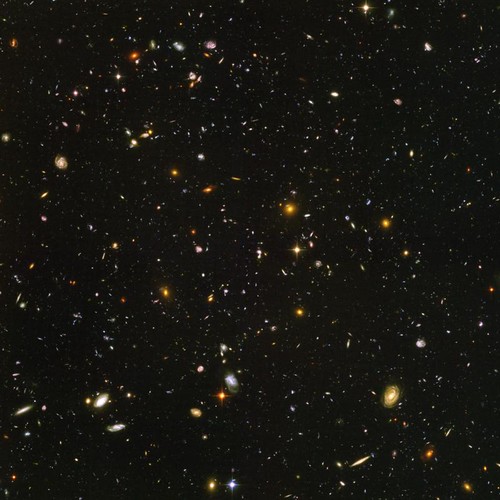
UDF, Credit: NASA, ESA, S. Beckwith (STScI) and the HUDF Team
The UDF looks back approximately 13 billion years (approximately between 400 and 800 million years after the Big Bang). Galaxies that existed in that time period would be very young and very different in structure and appearance than the grand spirals we see nearby today.
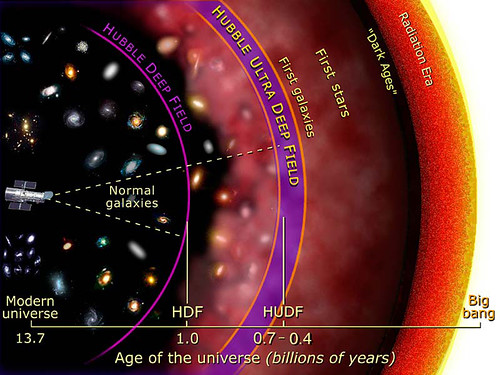
Credit: NASA
So, what is the farthest known object from Earth? There have been many candidates for this title in the last decade, but they are continually surpassed by new discoveries.
As of this writing it seems that one of the galaxies in the recent Hubble discovery I mentioned may be a distance record breaker. The redshift of the light observed from this galaxy (with a value of 11.9) tells us that the light was emitted about 380 million years after the Big Bang. This means the light from this galaxy (pictured below) left 13.3+ billion light years ago. Wow!
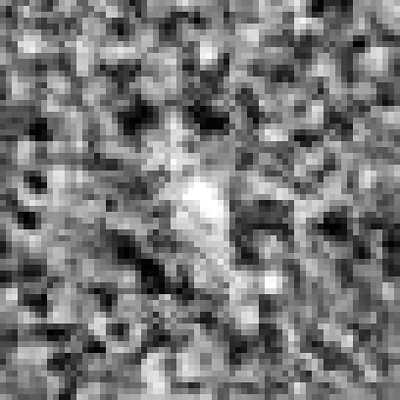
Credit: NASA, ESA, R. Ellis (Caltech), and the UDF 2012 Team
Just under a month ago, the current candidate was this object: a young galaxy called MACS0647-JD. It’s only a tiny fraction of the size of our Milky Way – and was observed at 420 million years after the Big Bang, when the universe was 3 percent of its present age of 13.7 billion years.
To spot this galaxy, astronomers used gravitational lensing. This effect occurs when a distant galaxy is fortuitously aligned with a massive galaxy cluster (in this case, MACS J0647+7015). The tremendously strong gravity of the cluster actually magnifies the light from the distant galaxy.

Credit: NASA, ESA, M. Postman and D. Coe (STScI), and the CLASH Team
Earlier in 2012, with the combined power of NASA’s Spitzer and Hubble Space Telescopes, as well as the use of gravitational lensing, a team of astronomers spotted what might then have been the most distant galaxy ever seen. Light from this young galaxy, MACS1149-JD, was emitted when our 13.7-billion-year-old universe was just 500 million years old.
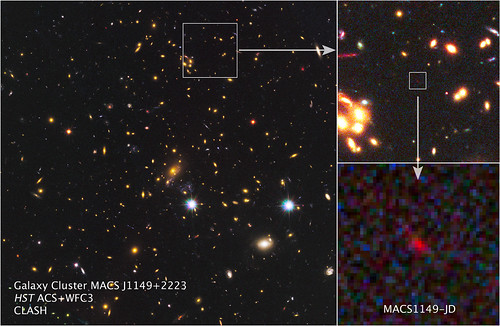
Credit: NASA, ESA, W. Zheng (JHU), M. Postman (STScI), and the CLASH Team
The objects in the Hubble UDF may well be the farthest known objects, but there have been other contenders.
They include a galaxy called Abell 1835 IR1916, which was discovered in 2004, by astronomers from the European Southern Observatory using a near-infrared instrument on the Very Large Telescope. This object is also visible to us because of gravitational lensing. This time is because the galaxy cluster Abell 1835 is between this distant object and us. This far off galaxy is thought to be about 13.2 billion light years away, which means it would date to about 500 million years after the Big Bang. Note though, that this find has not been verified by other instruments – the Spitzer Space Telescope tried in 2006 without success.
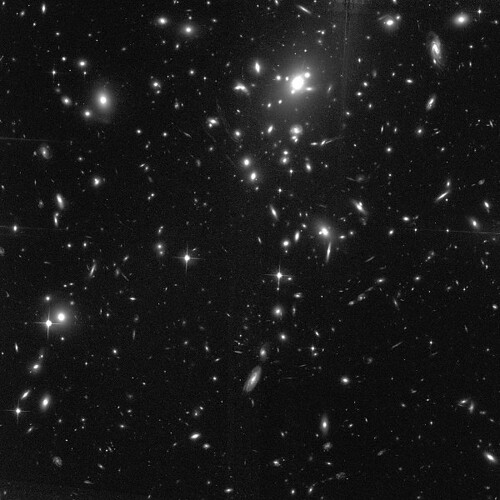
Abell 1835 by the Hubble, Credit: NASA
Also in 2004, a team using both the Hubble Space Telescope and the Keck Observatory discovered a galaxy that is believed to be about 13 billion years away from us. It was found when observing the galaxy cluster Abell 2218. The light from the distant galaxy was visible because of gravitational lensing. The very distant object is the one circled. For more information, check out this press release.
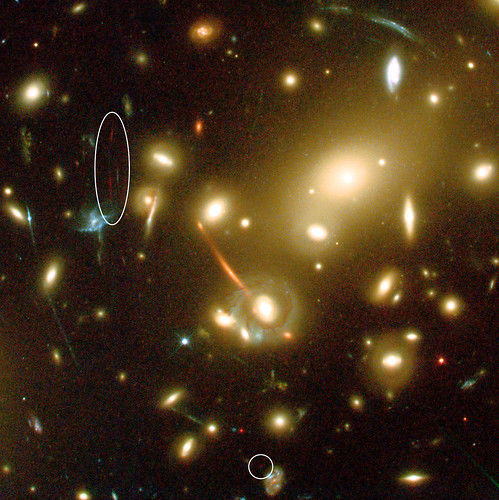
Credit: European Space Agency, NASA, J.-P. Kneib (Observatoire Midi-Pyrénées) and R. Ellis (Caltech)
Then there’s the infrared James Webb Space Telescope. If you recall from our discussion of the UDF12 survey, Hubble has near-infrared capability, but not mid-infrared, and for objects with very high redshifts, to see these most distant of objects would require a powerful telescope with mid-infrared capability. JWST will be able to see farther and deeper than was ever possible before.
In fact, one of JWST’s objectives is to look even further back, to just 200 million years after the Big Bang. One model of galaxy evolution has the first galaxies forming then and we need JWST to test this theoretical prediction!
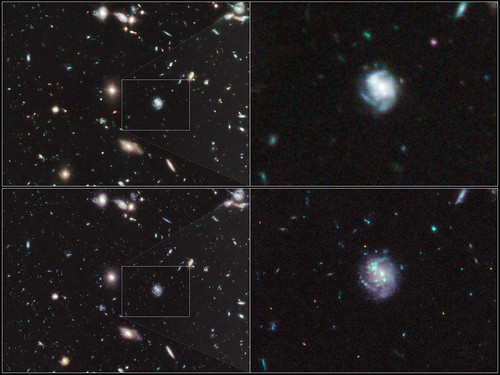
Top panels: Hubble UDF. Bottom: Simulation of what a JWST Deep Field might look like. Credit: STScI
(Note: JWST will be able to see these first galaxies without the aid of gravitational lensing; gravitational lensing might allow us to see them better, but would not necessarily let us see further back in time.)


